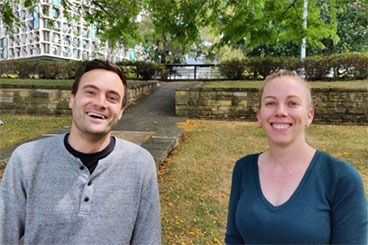Glia in Cognition Lab: Cullen Group

Most brain cells are glia – they far exceed neurons in number and diversity. They can be divided into five major types: neural stem cells; astrocytes; oligodendrocytes; oligodendrocyte progenitor cells (OPCs), and microglia. Our research team aims to learn how glial cells contribute to brain circuit function. We are particularly interested in the way that oligodendrocytes allow brain circuits to adapt with life experience.
Oligodendrocytes produce a fatty insulating substance called myelin, that they wrap around the long thin processes (axons) of electrically active neurons, allowing them to carry electrical impulses rapidly and reliably from one part of the brain to another. The addition of new myelin and the restructuring of existing myelin can fine-tune the speed of information transfer, and we are seeking to understand how these changes occur, and how this kind of plasticity helps us to think, feel and behave. We are particularly interested in understanding how aberrant myelination, or impaired myelin plasticity contributes to the development and severity of neuropsychiatric disorders.
We have research projects available for students interested in pursuing an Honours or PhD degree within the laboratory. Please contact Dr Carlie Cullen (Carlie.Cullen@utas.edu.au) for more information about the projects or to express your interest.
Parent Theme
Related Funding Bodies
Staff
Team Leaders
- Dr Carlie Cullen
Local Collaborators
- Associate Professor Kaylene Young
- Professor Bruce Taylor
- Dr Rob Gasperini
- Dr Catherine Blizzard
- Dr Brad Sutherland
- Dr Mark Hinder
- Dr Jessica Fletcher
- Dr Kimberley Pitman
- Dr Kalina Makowiecki
- Dr John Lin
External Collaborators
- Professor Jennifer Rodger (University of Western Australia)
- Professor Renaud Jolivet (University of Geneva)
- Associate Professor Ben Emery (Oregon Health and Science University)
- Associate Professor Ethan Scott (University of Queensland)
Related Publications
Cullen, CL and Pepper, RE and Clutterbuck, MT and Pitman, KA and Oorschot, V* and Auderset, L and Tang, AD* and Ramm, G* and Emery, B* and Rodger, J* and Jolivet, RB* and Young, KM, “Periaxonal and nodal plasticities modulate action potential conduction in the adult mouse brain”, Cell Reports, 34 (3). doi:10.1016/j.celrep.2020.108641 ISSN 2211-1247 (2021) [Refereed Article]
Cullen, CL and O'Rourke, M and Beasley, SJ and Auderset, L and Zhen, Y and Pepper, RE and Gasperini, R and Young, KM, “Kif3a deletion prevents primary cilia assembly on oligodendrocyte progenitor cells, reduces oligodendrogenesis and impairs fine motor function”, Glia pp. 1-20. doi:10.1002/glia.23957 ISSN 0894-1491 (2020) [Refereed Article]
Ferreira, S and Pitman, KA and Wang, S and Summers, BS and Bye, N and Young, KM and Cullen, CL, “Amyloidosis is associated with thicker myelin and increased oligodendrogenesis in the adult mouse brain”, Journal of Neuroscience Research pp. 1-28. doi:10.1002/jnr.24672 ISSN 0360-4012 (2020) [Refereed Article]
Ferreira, S and Pitman, KA and Summers, BS and Wang, S and Young, KM and Cullen, CL, “Oligodendrogenesis increases in hippocampal grey and white matter prior to locomotor or memory impairment in an adult mouse model of tauopathy”, European Journal of Neuroscience pp. 1 23. doi:10.1111/ejn.14726 ISSN 0953-816X (2020) [Refereed Article]
Cullen, CL and Senesi, M and Tang, AD* and Clutterbuck, MT and Auderset, L and O'Rourke, ME and Rodger, J* and Young, KM, “Low-intensity transcranial magnetic stimulation promotes the survival and maturation of newborn oligodendrocytes in the adult mouse brain”, Glia, 67 (8) pp. 1462-1477. doi:10.1002/glia.23620 ISSN 0894-1491 (2019) [Refereed Article]
Pepper, RE and Pitman, KA and Cullen, CL and Young, KM, “How do cells of the oligodendrocyte lineage affect neuronal circuits to influence motor function, memory and mood?”, Frontiers in Cellular Neuroscience, 12 Article 399. doi:10.3389/fncel.2018.00399 ISSN 1662-5102 (2018) [Refereed Article
Cullen, CL and Young, KM, “How does transcranial magnetic stimulation influence glial cells in the central nervous system?”, Frontiers in Neural Circuits, 10 Article 26. doi:10.3389/fncir.2016.00026 ISSN 1662-5110 (2016) [Refereed Article]